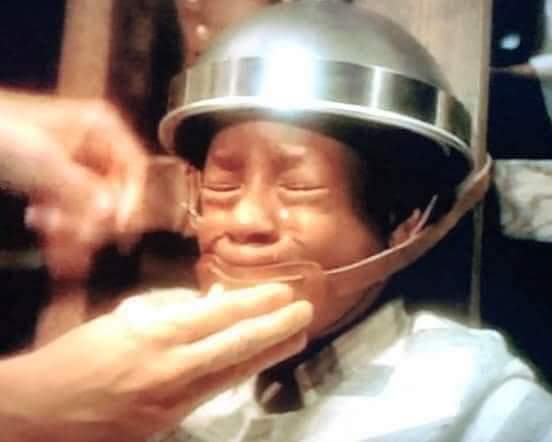
This is the disturbing tale of an innocent African American child who was sentenced to death in the electric chair after an all-white jury found him guilty of murder in just 10 minutes.
George Stinney Jr. was 14 years old when he was executed in 1944, making him the youngest person executed in the United States during the twentieth century.
George’s murder conviction was reversed by a South Carolina judge in December 2014, more than 70 years later.
In March 1944, he was charged with the gruesome double murder of two white girls in the small town of Alcolu, South Carolina.
On the “black hand” of the profoundly divided group, the bodies of Betty June Binnicker, 11, and Mary Emma Thames, eight, were discovered with their skulls broken.
A 1991 TV movie dramatises the execution of 14-year-old George Stinney Jr in 1944
A 1991 TV movie dramatises the execution of 14-year-old George Stinney Jr in 1944
The young boy was convicted by an all-white jury of the double murder of two white girls
The young boy was convicted by an all-white jury of the double murder of two white girls
He was taken from his home by cops who then claimed he confessed to the double murder despite no written confession ever being produced.
There was also no physical evidence linking him to the crime.
Live and Work in one of the six Gulf States!
EmployMeGulf
by TaboolaSponsored Links
His parents were never allowed to visit him following his arrest, his sister has claimed.
The infamous three-hour trial still hangs over South Carolina as one of the most horrifying miscarriages of justice ever carried out in the state.
George was sentenced to death by a jury of 12 white men who returned a guilty verdict after only 10 minutes of deliberation.
Just two months later, the 14-year-old child was led crying and shaking into the execution chamber.
While cops say George confessed to the crime, there was no documented evidence to back up any of their claims
While cops say George confessed to the crime, there was no documented evidence to back up any of their claims
According to local media accounts, the guards had difficulty strapping the tiny boy, who stood 5ft 1in tall and weighed just 95lb (6st 7 lbs), into the electric chair designed for adults.
They came up with the idea of having George sit on a dense telephone directory.
The first surge of 2,400 volts was blasted into his tiny body moments later, before the adult death mask, which was too heavy for him, fell off his face, exposing tears streaming down his cheeks.
On June 16, 1944, the boy was pronounced dead after two more electrical charges.
A South Carolina judge reversed George’s murder conviction in December 2014.
His parents were never allowed to talk to their son between his arrest and his execution
His parents were never allowed to talk to their son between his arrest and his execution
Judge Carmen Mullen revealed that the boy’s lawyer had called “few or no witnesses,” and failed to properly cross-examine his accusers.
His sister Amie Ruffner testified during the appeal process that her brother was at home on the day that two girls were killed and could not have possibly murdered them.
Amie said that that she watched her older brother being arrested by white policeman when she was just eight-years-old.
She says the next time she saw George was when she saw his “burned face” in an open casket at his funeral.
Amie says her family were hounded out of Alcolu because of the case and she has never returned since.
She said: “In those days, when you are white you were right, when you were black you were wrong.”
A 1991 TV movie titled Carolina Skeletons recreates the terrifying execution of the teenager.
The film was based on a book of the same by George’s nephew David Stout.
George’s murder conviction was reversed by a South Carolina judge in December 2014, more than 70 years later.
In March 1944, he was charged with the gruesome double murder of two white girls in the small town of Alcolu, South Carolina.
On the “black hand” of the profoundly divided group, the bodies of Betty June Binnicker, 11, and Mary Emma Thames, eight, were discovered with their skulls broken.
He was taken from his home by cops who then claimed he confessed to the double murder despite no written confession ever being produced.
There was also no physical evidence linking him to the crime.
His parents were never allowed to visit him following his arrest, his sister has claimed.
The infamous three-hour trial still hangs over South Carolina as one of the most horrifying miscarriages of justice ever carried out in the state.
George was sentenced to death by a jury of 12 white men who returned a guilty verdict after only 10 minutes of deliberation.
Just two months later, the 14-year-old child was led crying and shaking into the execution chamber.
While cops say George confessed to the crime, there was no documented evidence to back up any of their claims
According to local media accounts, the guards had difficulty strapping the tiny boy, who stood 5ft 1in tall and weighed just 95lb (6st 7 lbs), into the electric chair designed for adults.
They came up with the idea of having George sit on a dense telephone directory.
The first surge of 2,400 volts was blasted into his tiny body moments later, before the adult death mask, which was too heavy for him, fell off his face, exposing tears streaming down his cheeks.
On June 16, 1944, the boy was pronounced dead after two more electrical charges.
A South Carolina judge reversed George’s murder conviction in December 2014.
His parents were never allowed to talk to their son between his arrest and his execution
Judge Carmen Mullen revealed that the boy’s lawyer had called “few or no witnesses,” and failed to properly cross-examine his accusers.
His sister Amie Ruffner testified during the appeal process that her brother was at home on the day that two girls were killed and could not have possibly murdered them.
Amie said that that she watched her older brother being arrested by white policeman when she was just eight-years-old.
She says the next time she saw George was when she saw his “burned face” in an open casket at his funeral.
Amie says her family were hounded out of Alcolu because of the case and she has never returned since.
She said: “In those days, when you are white you were right, when you were black you were wrong.”
A 1991 TV movie titled Carolina Skeletons recreates the terrifying execution of the teenager.
The film was based on a book of the same by George’s nephew David Stout.












